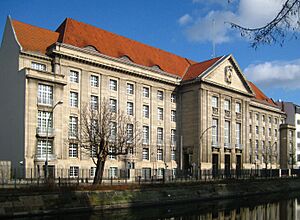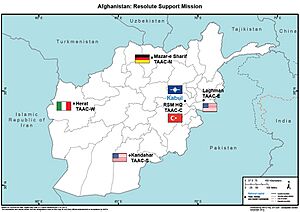Federal Ministry of Defence (Germany) facts for kids
| Bundesministerium der Verteidigung (BMVg) | |
 |
|
 Entrance to the Hardthöhe, Bonn |
|
| Agency overview | |
|---|---|
| Formed | 19191/19552 |
| Jurisdiction | Cabinet of Germany |
| Headquarters | Hardthöhe, Bonn, Germany 50°41′57″N 7°2′25″E / 50.69917°N 7.04028°E |
| Annual budget | €53 billion (2021) |
| Minister responsible |
|
| Agency executives |
|
| Website | http://www.bmvg.de |
| Footnotes | |
| 1: As the Ministry of the Reichswehr, succeeding the Ministry of War of Prussia, the Ministry of War of Saxony, the Ministry of War of Bavaria, the Ministry of War of Württemberg and the Imperial Naval Office 2: As the Ministry of Defence (Bundesministerium für Verteidigung) in West Germany |
|
The Federal Ministry of Defence (German: Bundesministerium der Verteidigung, often called BMVg) is a very important government office in Germany. It is in charge of Germany's armed forces, known as the Bundeswehr. The head of this ministry is the Federal Minister of Defence, who is part of the German government's main group, the Cabinet.
The main office of the ministry is in Bonn, at a place called Hardthöhe. There is also a second office in Berlin, in a building known as the Bendlerblock. Sometimes, people use the name Bendlerblock to refer to the whole ministry.
The German Constitution (Grundgesetz) says that the Federal Minister of Defence is the leader of the Bundeswehr during peacetime. The Bundeswehr has about 265,019 soldiers and civilian workers. If Germany is in a state of defence, the country's leader, the Chancellor, takes over as the main commander.
Around 3,730 people work for the ministry. Most of them (3,230) work in Bonn, while about 500 work in the Berlin office.
Contents
How the Ministry Works
The Federal Ministry of Defence changed how it was organized on April 1, 2012. It now has a clear structure to manage Germany's defence.
Top Leaders
- The Federal Minister of Defence is the highest leader. They are the commander of the German armed forces when there is no war.
- Two Parliamentary Secretaries of State help the Minister.
- Two Secretaries of State also support the Minister.
- Under these top leaders, there are special offices:
- A Support Office helps with daily tasks.
- A Press & Information Office shares news and updates.
- A Politics Directorate handles political matters.
Main Departments
The work of the ministry is divided into several main departments, each led by a Secretary of State or the Inspector General.
- Secretary of State #1 oversees:
- The Equipment Directorate, which handles all military gear.
- The Cyber & IT Directorate, created in 2016, which deals with computer and information technology for defence.
- Secretary of State #2 oversees:
- The Financial & Controlling Directorate, which manages money and budgets.
- The Personnel Directorate, which handles all staff and soldiers.
- The Infrastructure, Antipollution & Administrative Services Directorate, which looks after buildings, environment, and general services.
- The Legal Directorate, which deals with laws and rules.
- The Inspector General is the highest-ranking soldier. They oversee:
- The Plans & Policies Directorate, which makes future plans.
- The Strategy & Operations Directorate, which plans military actions.
- The Armed Forces Command & Control Directorate, which manages how the forces are directed.
Parts of the Bundeswehr
The Bundeswehr has two main parts: the military forces and the civilian administration. It includes 11 different services or departments:
- Military Forces:
- German Army (Heer)
- German Navy (Marine)
- German Air Force (Luftwaffe)
- Joint Medical Service (Zentraler Sanitätsdienst)
- Joint Support Service (Streitkräftebasis), which includes the Center for Military History and Social Sciences.
- Cyber- and Information Domain Service (Cyber- und Informationsraum), started in 2017.
- Civilian Administration:
- Personnel Management
- Information Technology & In-Service Management
- Infrastructure, Antipollution & Administrative Services
- Judicature (legal matters)
- Military Chaplaincy (religious support)
Directly Managed Offices
Several important offices and agencies report directly to the ministry:
- Armed Forces Operational Command, which leads military missions.
- Office for Military Aviation, which oversees military aircraft.
- Office for Plans & Policies, which helps with planning.
- Command & Control Academy, where military leaders are trained.
- Center of Leadership Culture, which focuses on leadership values.
- Military Counter-intelligence Service, which protects against spies and threats.
History of the Ministry
Early Years (19th Century)
Before 1871, when Germany became one country, there was no single national Ministry of War. Instead, larger German states like Prussia and Bavaria had their own war ministries. They were responsible for defending smaller states too. However, the Imperial Navy, Germany's navy at the time, had its own federal office from 1889.
Weimar and Nazi Germany
After World War I ended in 1918, Germany created a single national defence ministry. This new ministry, called the Ministry of the Reichswehr, was set up in October 1919. It was located in the Bendlerblock building in Berlin.
Under the new rules, the German President became the top commander of the armed forces. The Minister of Defence was in charge of military matters. The separate war ministries in the German states were closed. In 1935, when the German armed forces were renamed the Wehrmacht, the ministry became the Reichskriegsministerium (Reich Ministry of War).
Later, in 1938, Adolf Hitler took over the role of the Reich War Minister himself. The ministry's military office became the Oberkommando der Wehrmacht (OKW), which was the High Command of the Armed Forces.
After World War II
After World War II, West Germany began to rebuild its armed forces in 1950. This was done to help defend Western Europe against the Soviet Union. At first, this work was done secretly by an office known as Amt Blank.
On June 7, 1955, this office officially became the Ministry of Defence. The Bundeswehr was created, and Germany joined NATO in the same year. In 1956, Germany brought back military service for young men. The German military quickly became a large force in Western Europe. To show its importance, the ministry's name was changed slightly in 1961 to Bundesministerium der Verteidigung.
Until 1960, the ministry was in a different building in Bonn. From 1960 onwards, it moved to a new complex at Hardthöhe, where it is today.
After German Reunification
After German reunification in 1990, the Bendlerblock building in Berlin became a second main office for the ministry in 1993. Since the early 1990s, the German military has been involved in more international missions, including fighting in the Kosovo War in 1999.
The 21st Century
For almost 20 years, until August 2021, Germany sent its armed forces to Afghanistan. They were part of international missions like the International Security Assistance Force and later the Resolute Support Mission. German forces left Afghanistan on June 29, 2021.
List of Federal Ministers of Defence (since 1955)
Here is a list of the people who have served as the Federal Minister of Defence since the ministry was created in 1955. They have come from different political parties, mainly the CDU/CSU (Christian Democratic Union/Christian Social Union) and the SPD (Social Democratic Party).
Political Party: CDU/CSU SPD
| Name (Born-Died) |
Portrait | Party | Term of Office | Duration | Chancellor (Cabinet) |
||
|---|---|---|---|---|---|---|---|
| Federal Minister for Defence (1955–1961) Federal Minister of Defence (1961–present) |
|||||||
| 1 | Theodor Blank (1905–1972) |
 |
CDU | 7 June 1955 | 16 October 1956 | 1 year, 131 days | Adenauer (II) |
| 2 | Franz Josef Strauß (1915–1988) |
 |
CSU | 16 October 1956 | 9 January 1963 | 6 years, 85 days | Adenauer (II • III • IV) |
| 3 | Kai-Uwe von Hassel (1913–1997) |
 |
CDU | 9 January 1963 | 1 December 1966 | 3 years, 326 days | Erhard (I • II) |
| 4 | Gerhard Schröder (1910–1989) |
 |
CDU | 1 December 1966 | 21 October 1969 | 2 years, 324 days | Kiesinger (cabinet) |
| 5 | Helmut Schmidt (1918–2015) |
 |
SPD | 22 October 1969 | 7 July 1972 | 2 years, 259 days | Brandt (I) |
| 6 | Georg Leber (1920–2012) |
 |
SPD | 7 July 1972 | 16 February 1978 | 5 years, 224 days | Brandt (I • II) Schmidt (I • II) |
| 7 | Hans Apel (1932–2011) |
 |
SPD | 17 February 1978 | 1 October 1982 | 4 years, 226 days | Schmidt (II • III) |
| 8 | Manfred Wörner (1934–1994) |
 |
CDU | 4 October 1982 | 18 May 1988 | 5 years, 227 days | Kohl (I • II • III) |
| 9 | Rupert Scholz (born 1937) |
 |
CDU | 18 May 1988 | 21 April 1989 | 338 days | Kohl (III) |
| 10 | Gerhard Stoltenberg (1928–2001) |
 |
CDU | 21 April 1989 | 31 March 1992 | 2 years, 345 days | Kohl (III • IV) |
| 11 | Volker Rühe (born 1942) |
 |
CDU | 1 April 1992 | 26 October 1998 | 6 years, 208 days | Kohl (IV • V) |
| 12 | Rudolf Scharping (born 1947) |
 |
SPD | 27 October 1998 | 19 July 2002 | 3 years, 265 days | Schröder (I) |
| 13 | Peter Struck (1943–2012) |
 |
SPD | 19 July 2002 | 22 November 2005 | 3 years, 126 days | Schröder (I • II) |
| 14 | Franz Josef Jung (born 1949) |
 |
CDU | 22 November 2005 | 28 October 2009 | 3 years, 340 days | Merkel (I) |
| 15 | Karl-Theodor zu Guttenberg (born 1971) |
 |
CSU | 28 October 2009 | 3 March 2011 | 1 year, 126 days | Merkel (II) |
| 16 | Thomas de Maizière (born 1954) |
 |
CDU | 3 March 2011 | 17 December 2013 | 2 years, 289 days | |
| 17 | Ursula von der Leyen (born 1958) |
 |
CDU | 17 December 2013 | 17 July 2019 | 5 years, 212 days | Merkel (III • IV) |
| 18 | Annegret Kramp-Karrenbauer (born 1962) |
 |
CDU | 17 July 2019 | 8 December 2021 | 2 years, 144 days | Merkel (IV) |
| 19 | Christine Lambrecht (born 1965) |
 |
SPD | 8 December 2021 | 19 January 2023 | 1 year, 42 days | Scholz (cabinet) |
| 20 | Boris Pistorius (born 1960) |
 |
SPD | 19 January 2023 | Incumbent | 2 years, 322 days | |
See also



